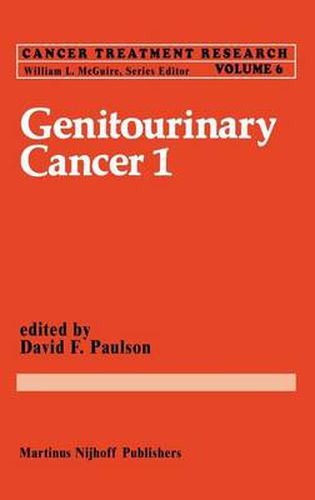Readings Newsletter
Become a Readings Member to make your shopping experience even easier.
Sign in or sign up for free!
You’re not far away from qualifying for FREE standard shipping within Australia
You’ve qualified for FREE standard shipping within Australia
The cart is loading…






This title is printed to order. This book may have been self-published. If so, we cannot guarantee the quality of the content. In the main most books will have gone through the editing process however some may not. We therefore suggest that you be aware of this before ordering this book. If in doubt check either the author or publisher’s details as we are unable to accept any returns unless they are faulty. Please contact us if you have any questions.
Malignant disease of the genitourinary tract continues to provide a major health hazard. The study of these disease processes has been hampered at the clinical level as there has been a serious lack of reasonably controlled treatment trials, and at the basic science level as many of the animal model systems do not compare favorably with the human tumor situation. This volume defines current cancer treatment and research and its appli cation to the control of human genitourinary malignancy. The authors have developed their chapters in such a way as to provide an up-to-date resource for the clinician who is involved in day-to-day patient care problems, for the clinician-investigator who is attempting to construct programs designed to evaluate the impact of current treatments, and for the clinician-scientist who is seeking to apply basic research technology and skills to understand ing and control in this disease area. This book does not attempt to cover the entire breadth of urinary malig nant disease, but focuses in depth on specific problem areas. It provides the reader with sufficient background and understanding for him to be able to evaluate future studies in the areas addressed, or even to develop his own projects. A reasonable balance has been established between clinical and basic research problems, recognizing that the two disciplines truly are not separable. The book serves to define the state of the art and, as such, will of urologic oncology.
$9.00 standard shipping within Australia
FREE standard shipping within Australia for orders over $100.00
Express & International shipping calculated at checkout
This title is printed to order. This book may have been self-published. If so, we cannot guarantee the quality of the content. In the main most books will have gone through the editing process however some may not. We therefore suggest that you be aware of this before ordering this book. If in doubt check either the author or publisher’s details as we are unable to accept any returns unless they are faulty. Please contact us if you have any questions.
Malignant disease of the genitourinary tract continues to provide a major health hazard. The study of these disease processes has been hampered at the clinical level as there has been a serious lack of reasonably controlled treatment trials, and at the basic science level as many of the animal model systems do not compare favorably with the human tumor situation. This volume defines current cancer treatment and research and its appli cation to the control of human genitourinary malignancy. The authors have developed their chapters in such a way as to provide an up-to-date resource for the clinician who is involved in day-to-day patient care problems, for the clinician-investigator who is attempting to construct programs designed to evaluate the impact of current treatments, and for the clinician-scientist who is seeking to apply basic research technology and skills to understand ing and control in this disease area. This book does not attempt to cover the entire breadth of urinary malig nant disease, but focuses in depth on specific problem areas. It provides the reader with sufficient background and understanding for him to be able to evaluate future studies in the areas addressed, or even to develop his own projects. A reasonable balance has been established between clinical and basic research problems, recognizing that the two disciplines truly are not separable. The book serves to define the state of the art and, as such, will of urologic oncology.